What's inside
Are your quads as defined as you’d like?
As you’re improving your physique, it’s an inevitable question. After all, the quadriceps are some of the most impressive muscles of the body, especially the lower half.
Like the biceps of the upper arm, strong quads will showcase your dedication. They’re essential to that head-turning athletic physique.
But have you ever wondered what it takes to build strong outer quads, specifically developing that bold outer quad sweep?
It’s a question I have been asked countless times over my career as a trainer.
Today, I am going to share the 10 best outer quad exercises for strong and defined quads.
Let’s dive in.
What is the outer quad?
Related: How To Get Big Legs?
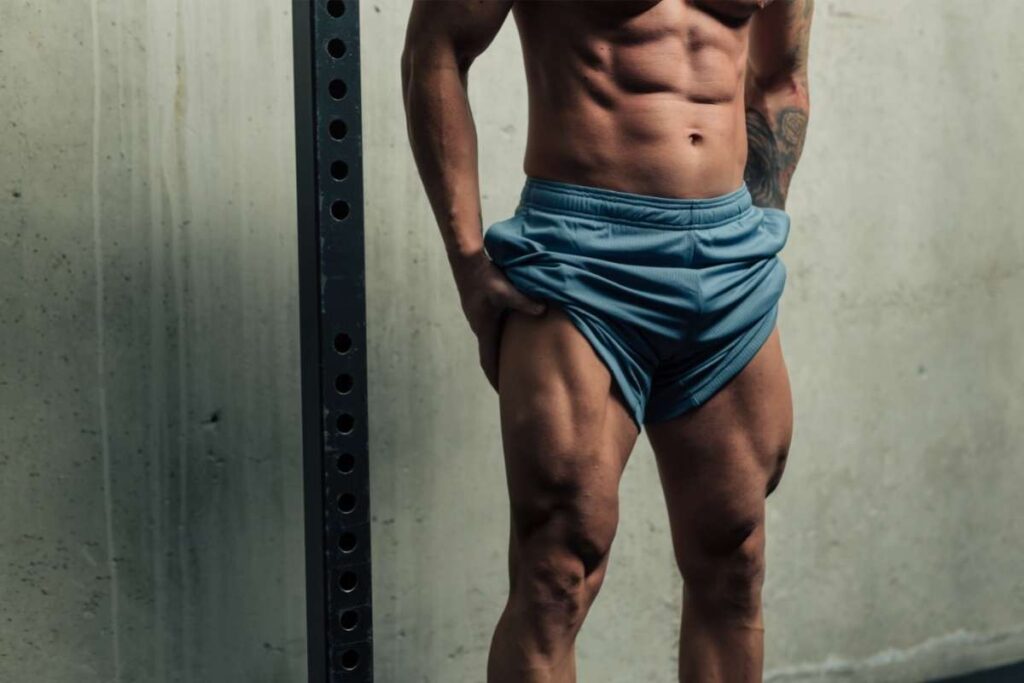
The quadriceps are the muscles on the front of your thighs.
The outer quad is one of four quad muscles. It’s the lateral aspect of the quadriceps muscle that is made up of the vastus lateralis (VL) and is sheathed by the iliotibial tract (ITB).
Anatomy of the Outer Quad
The outer quad is made up of the vastus lateralis (VL) which originates at the greater trochanter of the femur and inserts into the tibial tuberosity.
The VL is responsible for the extension of the knee.
Covering this is the tensor fasciae latae (TFL) which sweeps down from the iliac spine and inserts down into the iliotibial tract, and into the tibial tuberosity.
The TFL is responsible for movements such as abduction, flexion, and internal rotation of the hip.
What is the outer quad sweep?
The outer quad sweep is the broad lateral aspect quadriceps that provides width and fullness to our upper legs.
This is made up of the vastus lateralis which is anatomically the largest of the four quadricep muscles.
Factors to Consider When Deciding on Outer Quad Exercises
Here is a list of factors that will help you decide on the best outer quad exercises for you.
Experience Level
When choosing your outer quad exercises, be realistic about your experience.
Many of the movements in the gym are accessible to lifters such as squats, lunges, and leg presses.
Variations such as the pendulum squat, heavy back squat, and Bulgarian split squat may be better once you have a better understanding of the hip hinge and squat mechanics.
The best way to approach this is to start with the basics and gradually increase resistance.
From there, you can build more complex lifts.
Training Goals
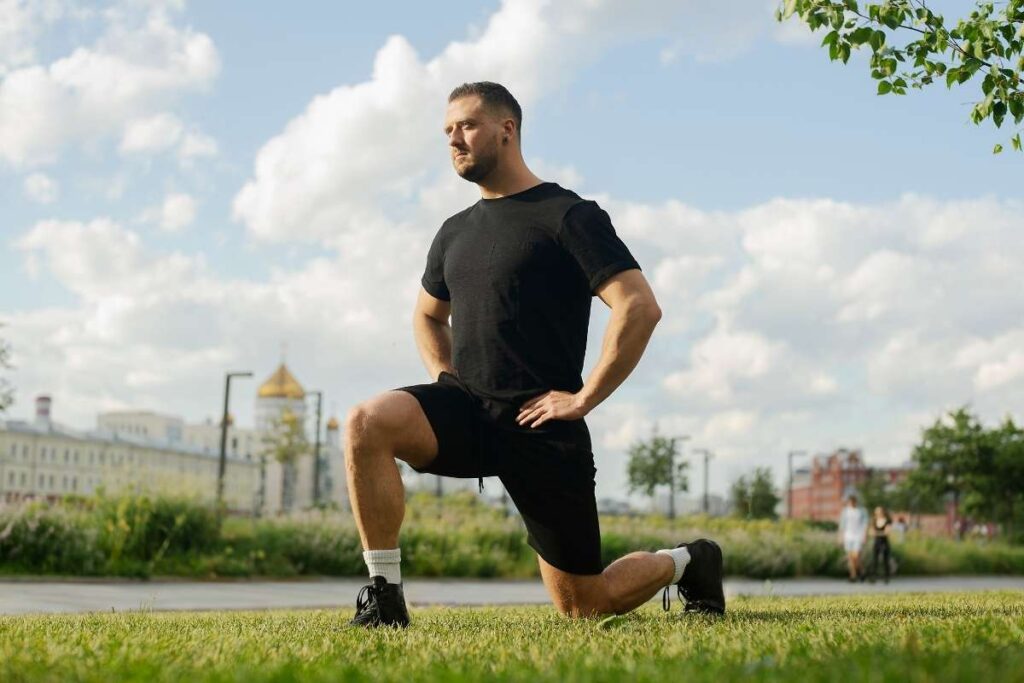
For the average gym goer, a simple routine of squats, lunges, and leg presses may suffice.
However, for a lifter looking to pack on serious mass, a larger variety to increase the volume of outer quad training may be required to promote greater hypertrophy.
Time
The amount of time you have to train can play a huge role in the exercises you select.
For example, someone who is looking to develop their outer quad but has limited time should focus on large compound lifts, such as squats, lunges, and leg presses.
Those who can afford to spend more time and want to build mass can increase the number of exercises per session to increase volume.
This can be made up of large compound lifts and isolation exercises.
Prior Injury
For many knee-related injuries, leg training is the best form of recovery. However, this should be done gradually.
Movements such as squats and lunges can be beneficial.
Exercises that utilize a rail-based system, such as horizontal leg press, require less balance and can be great to control resistance.
Main Benefits of Exercising the Outer Quad
Related: How To Gain Weight In Buttocks And Thighs?
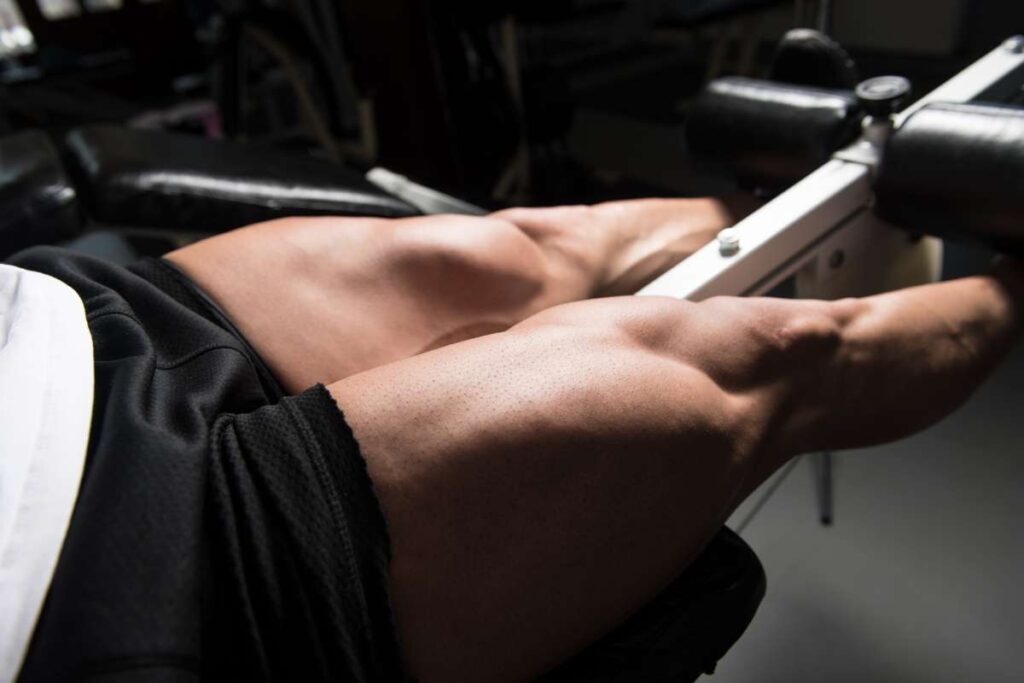
Developing your outer quad sweep is a great way to improve your physique and function.
Below is a list of benefits of exercising the outer quad.
Increased Muscle Mass
Targeting the outer quads can go a long way to increasing the muscle mass through your legs.
The VL is considered the longest of the quadricep muscles and increasing its size can add considerable size to your physique.
Training structured around one to three sets of 8-12 repetitions of your one repetition maximum (1RM) has been indicated to promote muscle hypertrophy.
Improve Strength
Related: Hypertrophy Vs Strength Training
Increasing muscle size and strength of the vastus lateralis will improve your overall quadriceps strength.
As we train our outer quads, we will build more complete muscle. This improves our lifts in the gym and our function in our daily life.
Definition
The outer quad provides our lateral quad with a bold border that defines our anterior and lateral thighs.
While the outer quad provides us with a bold broad sweep. It also creates definition where it meets the rectus femoris anteriorly and laterally with the TFL and hamstring.
By developing your outer quad, you will not only increase mass but define your entire lower leg.
Improved Function
Training the outer quad can help to improve lower body function.
The vastus lateralis of the outer quad is the largest component of the quadriceps.
These fibers are responsible for posture and stability of the lower body, and extension of the knee.
By improving the strength and mass of these fibers we can improve our function during daily tasks such as squatting, running, and walking.
Drawbacks of Weak Outer Quad
When the outer quad is weak, the following issues may arise.
Knee Pain
Weakness through the quadricep muscles has been associated with knee pain.
The quadriceps muscles are responsible for the extension and stability of the knee. When there is weakness surrounding the muscles that support the knee, an increased level of stress is placed on the joint.
Research has indicated that weakness in the quadriceps muscles can increase knee pain over time.
Loss of Strength
Weakness of the outer quad can lead to reduced strength output.
This can be concerning for lifters, as it can decrease their ability to push large amounts of weight.
When the outer quad becomes weaker, movements such as squats, lunges, and pushing movements with the legs become more difficult.
Impaired Function
If the outer quad is underperforming, other muscles may compensate to aid in knee extension.
When this happens, pain and dysfunction can occur.
From here simple day-to-day movements including standing up, stepping up, and sitting down can become increasingly difficult.
If this pain continues, it furthers muscle inhibition, with research suggesting that an increase in pain over time will occur.
How to Build Outer Quads
To build the outer quads, we will need to take the knee through extension and progressive overload.
To promote muscle growth, one to three sets of 8-12 receptions at 60%-80% 1RM are required.
Combine this with a recommended protein intake of 1.6-2.2g of protein per kilogram of body weight, to aid in muscle growth and recovery.
How to work the outer quad?
Exercises such as squats, lunges, leg presses, and step-ups are all great, functional movements that work the outer quad.
10 Best Outer Quad Exercises to Include in Your Workout Routine
Related: Top 10 Inner Thigh Exercises
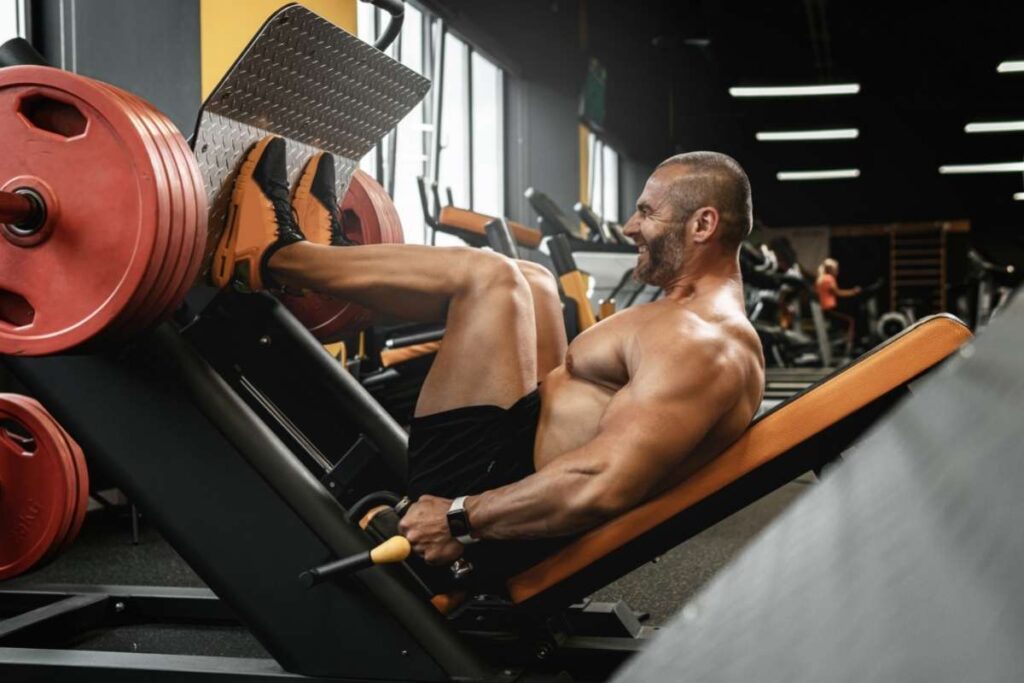
Here is a list of the 10 best outer quad exercises to develop a bold quad sweep.
1. Back Squat
The back squat is one of the cornerstones of any gym workout. With its ability to build mass through the lower body, it’s near unmatched for quad development.
Equipment Requirements
- Barbell
- Weight Plates
How To Perform Back Squat
- Standing in front of the squat rack, walk under the bar and position it on your back across your rear delts.
- Push up with your legs and take the weight of the bar off the rack.
- Take two steps back and position your feet shoulder-width apart.
- To begin, unhinge the hips and gradually lower them until they are parallel with the floor.
- Once you reach the bottom, push back up using both legs until you reach the starting position. Repeat.
Benefits
- Increase lower body mass
- Increase strength
Pro Tip
- Prior to each repetition, inhale and brace your core and exhale as you push up. This will help your core remain rigid throughout the movement.
- As you come up from the squat, tense your glutes to lock out the movement. This will help you lift using the hip, which will reduce pressure on the knees.
2. Front Squat
The front squat is a brilliant exercise for developing the outer quads.
The front rack position reduces spinal load and shearing force at the knee.
This allows you to load up the legs without the additional pressure through the knees.
Equipment Requirements
- Barbell
- Weight Plates
How To Perform Front Squat
- Standing in front of a squat rack, walk yourself under the bar and position it on your collarbone.
- Lift arms up, bend elbows, and hook your thumbs under the bar.
- Push up with your legs to take the weight of the bar.
- Take two steps back.
- To begin, lead back with the hips and lower yourself down to the floor.
- Lower until your knees are bent at 90 degrees.
- Once you reach the bottom, drive up using both legs back to the upright position. Repeat.
Benefits
- Reduced knee and spinal loading
- Build quads
Pro Tip
- Focus on breathing for each rep. Inhale before lowering and exhale as you push back up to the starting position.
- Keep elbows up throughout the entire set. This will secure the bar on your collarbone for the duration of the set.
3. Leg Press
Related: The Ultimate Guide To Leg Press Foot Placement
The leg press is an excellent machine that removes elements of stability and balance and allows you to focus on pushing large amounts of weight.
Equipment Requirements
- Leg Press
How To Perform Leg Press
- Take a seat on the leg press and place your feet shoulder-width apart midway up the platform.
- Push legs up to take the weight of the carriage and unlock the safety lock.
- Bend your knees and gradually lower the carriage down until your knees are bent at 90 degrees.
- Once at the bottom, push the carriage back up to the starting position. Repeat.
Benefits
- Great for building mass
- The rail system allows you to focus on pushing the weight
Pro Tip
- Place your feet mid-way up the platform. This will allow you to get a comfortable depth while still providing you with room to generate the necessary force to push the carriage back up.
- Focus on your breathing, inhaling as you lower and exhaling as you push the carriage up.
4. Barbell Walking Lunges
The barbell walking lunge takes the functional benefits of the walking lunge and allows you to load up the weight with the barbell.
The lunge is a great exercise for overall lower development, as the alternating stepping motion targets the muscles of the quads, glutes, and hamstrings.
Equipment Requirements
- Barbell
- Weight Plates
How To Perform Barbell Walking Lunges
- Standing with a barbell resting on your back across your rear delts.
- Take a step forward with one foot to assume the split stance.
- Drop the rear knee directly back down to the floor until both knees are bent at 90 degrees.
- Using both legs, push up and have your rear leg stride forward to meet the front leg.
- Alternate legs in a walking motion and repeat until you complete the set.
Benefits
- Builds lower body mass
- Functional movement
Pro Tip
- When performing the lunge, focus on lowering the back knee directly to the floor. This will help you perform the perfect lunge.
- Between each lunge, have your legs meet together. This will allow you to tense your glute and abs and reset before your next repetition.
5. Reverse Hack Squat
The reverse hack squat is an exercise that allows you to load up and push some serious weight.
As the machine is set on rails, there is no need to balance and stabilize.
Equipment Requirements
- Hack Squat Machine
How To Perform Reverse Hack Squat
- Facing forward, step onto the hack squat platform, lean forward, and position your shoulders under shoulder pads.
- Place feet shoulder-width apart, and then push up to take the weight of the carriage.
- Release the safety lock.
- To begin, lead back with the hips and lower yourself down toward the platform.
- Lower until your knees and hips are bent at 90 degrees.
- Once you reach this position, push up with both legs until you return to the starting position. Repeat.
Benefits
- Develops glute and hamstring strength
- The rail system allows you to focus on quad contraction
Pro Tip
- Inhale before you start lowering and exhale as you push up.
- During the course of your reps, focus on your quad contraction and squeezing the muscle. This will help improve your mind-muscle connection and improve your quad activation.
6. Elevated Heel Squat
The elevated heel squat allows for great depth with increased load for the quads.
When the heels are lifted, the front of the ankle opens up and allows for greater depth, which increases activation.
Equipment Requirements
- Platform
How To Perform Elevated Heel Squat
- Stand with heels elevated on a small platform.
- Unhinge at the hips and lower yourself down toward the floor.
- Lower yourself until your knees are bent 100 degrees.
- From here push back up to the upright stance. Repeat.
Benefits
- Elevated heels allow for greater depth
- Increased depth increases quad activation
Pro Tip
- To get the most out of the movement try to squat to full depth. This will increase your quadriceps activation.
- Focus on your breathing, inhaling as you lower and exhaling as you push up.
7. Bulgarian Split Squat
Bulgarian split squats reduce pressure through the knees while targeting the quads.
Equipment Requirements
- Dumbbells
- Bench
How To Perform Bulgarian Split Squat
- Stand to the side of a bench facing away.
- Reach back with one leg and place the top of your foot on the bench behind you.
- To begin the movement, lower the back knee directly down to the floor.
- Lower until the front knees are bent at 90 degrees.
- Once you reach the position, push back up to the upright position.
- Complete all reps on this leg and then switch sides.
Benefits
- Develops quads
- Reduces knee pressure
Pro Tip
- For your back leg, have the top of your foot resting on the bench. This will allow for greater balance.
- Inhale as you lower and exhale as you push back up.
8. Pendulum Squat
The pendulum squat is an advanced squat movement that is great for targeting the quads.
Equipment Requirements
- Pendulum Squat Machine
How To Perform Pendulum Squat
- Step into the pendulum squat and place your shoulders under shoulder pads.
- Place feet on the platform in front with feet shoulder-width apart.
- Push up to take the weight and remove the safety lock.
- Begin by bending your knees and slowly lowering yourself down toward the platform.
- Lower until your knees are bent between 90-110 degrees.
- Once you reach this position, push up back to the starting position. Repeat.
Benefits
- Pendulum squat angle increases quad activation
- Builds quad mass
Pro Tip
- For beginners, perform with a lighter weight and familiarize yourself with the pendulum mechanism. Gradually increase the weight once you get comfortable with the movement.
- Focus on a range of motion and quad activation when performing the pendulum squat. This machine needs little weight to be effective.
9. Belt Squat
The belt squat is great for loading up the lower body while reducing compressive force on the spine and knees.
Equipment Requirements
- Belt Squat Machine
How To Perform Belt Squat
- Step onto the belt squat platform and wrap the weight belt around your waist.
- Hook the weight belt to the chain.
- Stand up and take the weight with a belt around your waist.
- Release the safety bars.
- To begin, unhinge at the hips and lower until they are parallel with the platform.
- Once at the bottom, push up with both legs until you are upright once again. Repeat.
Benefits
- Reduces spinal loading
- Builds lower body mass
Pro Tip
- For beginners, start with a lighter weight. The belt squat is safe, however, unfamiliar bar mechanics can take some time to get used to.
- Gradually lower and push up through both quads, focusing on contracting your quads.
10. Single Leg Hack Squat
The single-leg hack squat takes the rail-based benefits of the hack squat and allows you to develop unilateral leg strength.
Equipment Requirements
- Hack Squat Machine
How To Perform Single Leg Hack Squat
- Step into the hack squat and rest your back against the carriage pad with your shoulders under the shoulder pads.
- Place one foot on the platform, midway up, with your other leg hanging down in the space below.
- To begin, bend your knee and slowly lower yourself down until your knee is bent at 90 degrees.
- Once at the bottom, push back up to the starting position.
- Complete all reps for this leg and then switch sides.
Benefits
- Develops unilateral leg strength
- Increase mass
Pro Tip
- Place your foot mid-way up the platform. This will help you reach a comfortable depth and give you the space to generate the force to push back up to the starting position.
- Focus on breathing, inhaling as you lower, and exhaling as you push back up.
The Best Outer Quad Workout Program
Related: How To Burn 1000 Calories Per Day
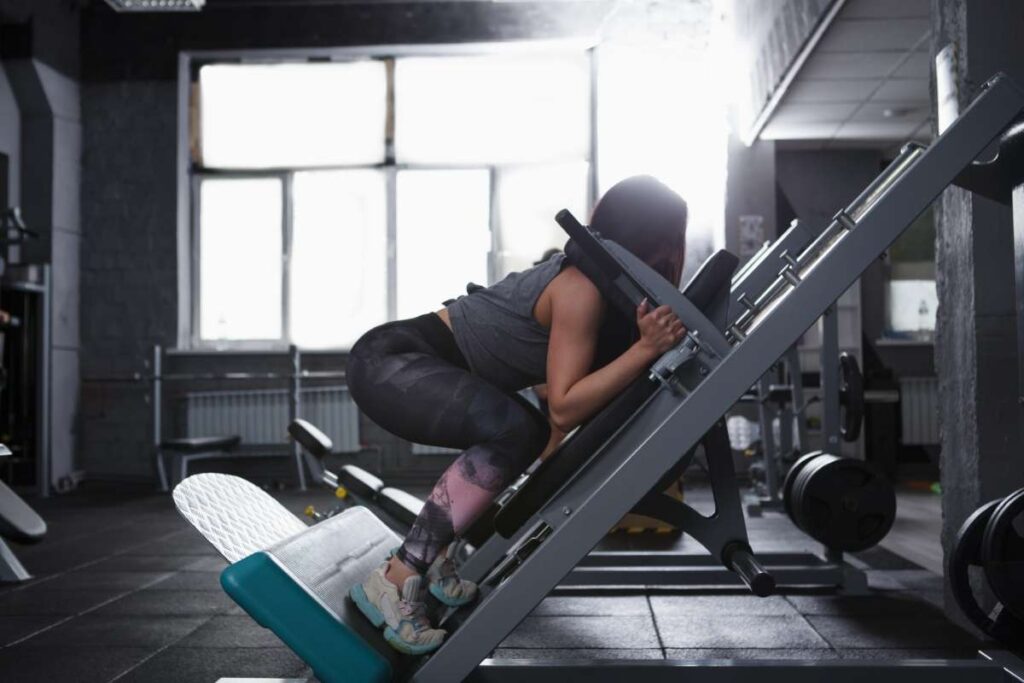
Here is the best outer quad workout program for beginners and advanced lifters.
Each program will have its own schedule and specific split so you can maximize your outer quad training.
Beginners
The beginner program is created around an upper and lower body split.
This allows you to train your lower body twice per week, with at least two programmed rest days.
Weekly Schedule – Upper/Lower Split
| Mon | Tues | Wed | Thurs | Fri | Sat | Sun |
| Upper | Lower | Rest | Upper | Lower | Rest | Rest |
Upper Body
| Exercise | Sets | Reps | Rest |
| Bench Press | 3 | 8-12 | 45 – 60 secs |
| Dumbbell Press | 3 | 10 | 45 – 60 secs |
| Lat Pulldown | 3 | 8-12 | 45 – 60 secs |
| Seated Row | 3 | 10 | 45 – 60 secs |
| Shoulder Press | 3 | 10 | 45 – 60 secs |
| Dumbbell Bicep Curls | 3 | 8-12 | 30 – 45 secs |
| Cable Tricep Extensions | 3 | 10 | 30 – 45 secs |
Lower Body
| Exercise | Sets | Reps | Rest |
| Back Squat | 3 | 8-12 | 30 – 45 secs |
| Barbell Walking Lunges | 3 | 10 | 45 – 60 secs |
| Reverse Hack Squat | 3 | 8-12 | 45 – 60 secs |
| Leg Press | 3 | 10 | 45 – 60 secs |
| Elevated Heel Squat | 3 | 12 | 45 – 60 secs |
Advanced
The advanced outer quad routine is based on a push, pull, and legs split.
This will allow you to train on back-to-back days with four leg sessions per week and two programmed rest days.
The program schedule will continue the pattern, alternating through the following week.
Weekly Schedule – Push Pull Legs Split
| Mon | Tues | Wed | Thurs | Fri | Sat | Sun |
| Push | Pull | Legs | Rest | Push | Pull | Rest |
Push
| Exercise | Sets | Reps | Rest |
| Barbell Back Squat | 4 | 8 | 45 – 60 secs |
| Bulgarian Split Squat | 4 | 8 | 45 – 60 secs |
| Pendulum Squat | 3 | 8-12 | 45 – 60 secs |
| Leg Press | 4 | 8 | 45 – 60 secs |
| Bench Press | 4 | 8 | 45 – 60 secs |
| Shoulder Press | 4 | 8 | 30 – 45 secs |
| Dips | 3 | 12 | 30 – 45 secs |
Pull
| Exercise | Sets | Reps | Rest |
| Deadlifts | 4 | 8-10 | 45 – 60 secs |
| Chin Ups | 4 | 8 | 45 – 60 secs |
| Lat Pulldown | 3 | 10 | 45 – 60 secs |
| Seated Row | 4 | 8 | 45 – 60 secs |
| Dumbbell Bent Over Row | 4 | 8 | 45 – 60 secs |
| Dumbbell Bicep Curls | 3 | 10 | 45 – 60 secs |
Legs
| Exercise | Sets | Reps | Rest |
| Front Squat | 4 | 8 | 30 – 45 secs |
| Reverse Hack Squat | 4 | 10 | 45 – 60 secs |
| Barbell Walking Lunges | 3 | 8-12 | 45 – 60 secs |
| Belt Squat | 4 | 8 | 45 – 60 secs |
| Leg Press | 4 | 8 | 45 – 60 secs |
| Elevated Heel Squat | 4 | 15 | 45 – 60 secs |
Thinking of increasing your leg training? Check out 14 Alternative Leg Press Exercises.
Pro Tips for Training the Outer Quad Effectively
Here are some pro tips to help you target your outer quads.
Calorie Surplus
When lifting to increase muscle mass, it is important that we provide our body with enough fuel to not only increase mass but perform our workouts.
When we set out to build muscle it is recommended that we eat a calorie surplus.
The recommended calorie intake for men is 2,500 and 2,000 for women.
Research indicates that a calorie surplus of 15% should be required to assist in muscle hypertrophy.
Foods should be nutrient-dense and high in protein.
Eat Protein

To build a bold and defined outer quad, we must increase our protein intake.
Over many years, I have seen many fall short of their goal due to poor nutrition.
They put in the work but don’t give their bodies the fuel to build muscle.
If you are looking to increase muscle mass, 1.6-2.2g of protein per kilogram of body weight is required to aid in muscle growth and recovery.
Focus on Muscle Contractions
When training to increase muscle mass, we must actively squeeze and contract our target muscles.
Research has shown that tensing and focusing on target muscles during sets can increase muscle activation for that mind-muscle connection.
When we can deliberately contract our target muscles during lifts, we can ensure that we effectively hit them with each rep.
When it comes to targeting the outer quad, we must take the knee into extension.
With a movement such as the squat, when we push up, we can actively focus on extending the knee and squeezing the quadriceps muscle.
This ensures that we are building and developing a strong outer quad.
Increase Leg Training Volume
A great way to improve your chances of jacking up your quads is to increase your training volume.
It has been scientifically identified that an increase in training volume can lead to the greater promotion of muscle hypertrophy.
This is where the implementation of a split routine comes in, as they allow you to increase the volume of training, while still getting the required rest.
Do you need help with your protein intake? Check out 25 Protein Boosters To Increase Your Protein.
Final Thoughts
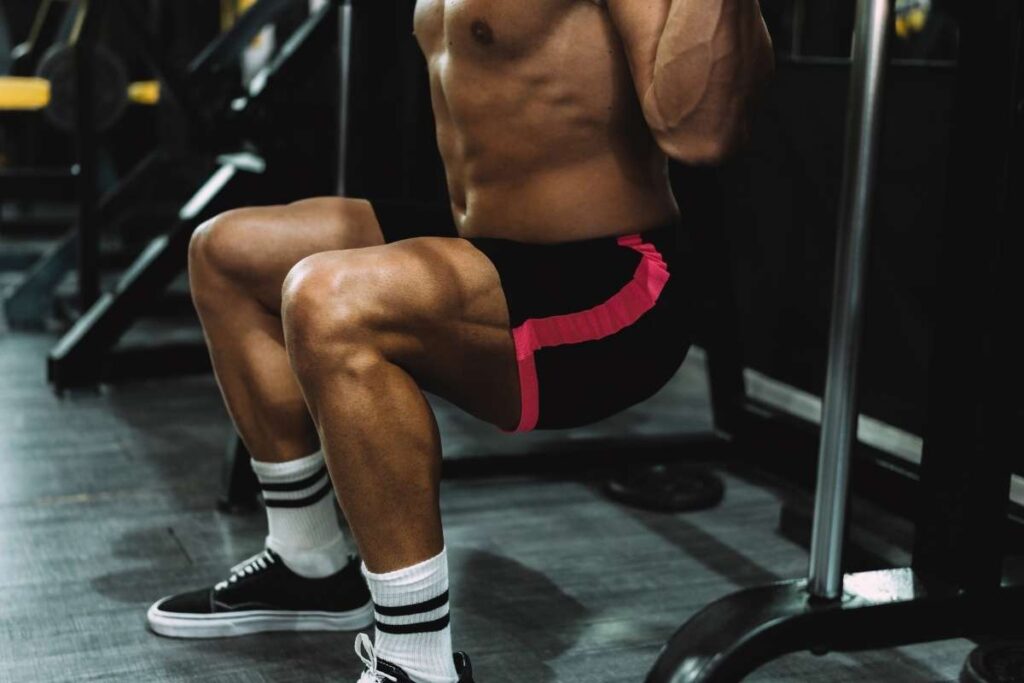
Having a strong set of quads is not only beneficial for function but can be aesthetically pleasing.
In particular, the outer quad provides considerable mass and definition to the anterior thigh.
So, if you are looking to increase the size of your outer quad, focus on eating a calorie surplus, hit your protein targets, and increase your leg training volume.
You tick these boxes and those quads will grow!
So, are you thinking of developing your outer quad sweep or trying the workout?
Let us know in the comments below, and share this with anyone else who might need help building their quads.
How to target outer quads?
The vastus lateralis’ main action is knee extension. To target this outer quad muscle, we need to take the knee to an extension to have the muscle contract.
Exercises such as squats, lunges, step-ups, and leg presses are all great exercises for targeting the outer quad.
How to hit outer quads?
To hit the outer quad we need to take the knee through a full range of motion of flexion and extension under resistance.
Movements such as squats and leg press performed where the knee is flexed to 90 degrees or greater have the best results for quadricep activation.
How to grow the outer quad?
To grow the outer quad, a focus on progressively overloading the muscle is required.
Increasing training volume by training the quadriceps multiple times per week, with sets of 8-12 repetitions at 60%-80% 1RM is the most effective way to prompt muscle hypertrophy.
How do you build an outer sweep on a quad?
To build the outer quad sweep, a focus on taking the knee through a full range of motion from flexion to extension with progressive overload is required.
This can be done through exercises such as squats, lunges, and leg presses.
How often should you train your outer quads?
You can train the outer quads two to four times per week provided that you have at least 48 hours of recovery between sessions.
Science has recommended that for muscles to repair following bouts of intense resistance training, recovery of 48-72 hours is required.
This can be done using a split program that allows you to train opposing muscle groups on back-to-back days.
A split such as push, pull, and legs will allow you to hit the legs three to four times per week and still give you your scheduled rest day for recovery.
What causes a tight vastus lateralis?
The vastus lateralis is the largest component of the quadriceps and is responsible for extension of the knee, stability, and posture of the leg.
The vastus lateralis will tighten when weakness throughout the other parts of the knee due to trauma, or dysfunction.
This is done by the body to compensate for the weakness of other fibers such as the vastus medialis.
How to release the vastus lateralis muscle?
A combination of medial quadricep activation, stretching, and soft tissue therapy can be used to release the vastus lateralis.
While there is limited research on the effects of massage and the reduction of muscular tension, there is evidence to suggest that activation of the vastus medialis helps reduce vastus lateralis tension.

